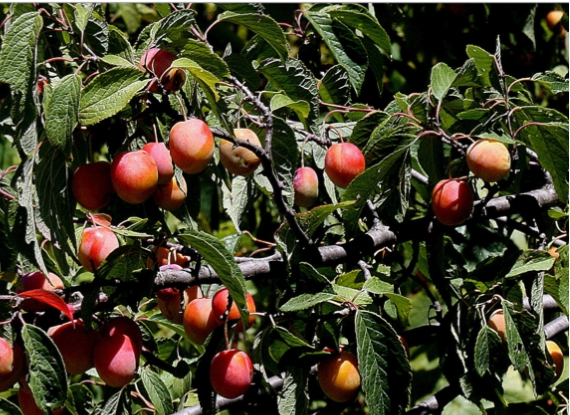- 2024 Native Trees
- >
- Native Trees
- >
- American Plum (Prunus americana)
American Plum (Prunus americana)
Height: 15 to 20 feet
Spread: 10 to 15 feet
Bloom Time: March to April
Bloom Description: White
Sun: Full sun to part shade
Suggested Use: Fruit and Specimen Tree
Attracts Birds and Pollinators
Native to Jefferson County
A perfect tree species for those with a “black-thumb” as the tree seemingly thrives with neglect.
On the perimeter of the Mingo village on the banks of the Ohio River were thick groves of the American Plum that provided food and medicine to the residents and visitors of the community. The Mingo called the tree kęé, and used the leaves to cure fever.
Joseph Doddridge noted that the plums were abundant in the area and filled the fertile valleys of the upper Ohio River watershed. Their abundance was so great that one stream in Wells Township was said to have so many trees along its banks and riparian that every year when the fruit dropped the water was replaced by the fruit and the stream would run with plum. Thus the stream and area was forever named Plum Run.
Prunus americana typically grows from a single stemmed trunk, but if left unattended will colonize into a mass grouping or thicket. Flowers are pure white in color and bloom in March to April, and are about 1 inch in diameter. Flowers last anywhere between 5 and 14 days, with the average being around one week depending on the temperatures and weather conditions. Different colonies of plum trees may have different bloom times, with some colonies being in full bloom while neighboring colonies have yet to bloom. Flowers have an extremely sweet fragrance.
American Plum trees are most known for their fruit. Fruit are ripe on the plant in June to July and are about an inch long and are yellow to red in color. Humans consumption of the fruit usually comes in the forms of jams and jellies or dried into a prune.
As with all good things there are some caveats. Fruit pits contain cyanide compounds, which are poisonous. If a couple of pits are accidentally swallowed, it will not cause poisoning. The pits are more poisonous if they are ground up/crushed or the seeds are chewed, so do not add fruits that have not been pitted into smoothies. Be cautious with the trees around domesticated animals, as they should not consume large quantities.
As far as wildlife is concerned the fruits are eaten by songbirds, wild turkeys, quail, white-tailed deer, and small mammals. Deer also eat the twigs and leaves. The American Plum is the host plant to 381 species of butterflies and moths. ■






